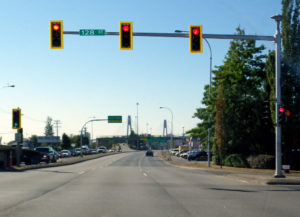When you sit at a traffic light, frustrated that it takes so long to turn green, consider that in one sense it never will. Traffic lights are among mankind’s greatest inventions for safety, and among our worst for the environment.
Numerous studies attest to the inefficiency of cars idling in traffic. The amount of fuel wasted, and the cost associated with it, are far beyond what most of us imagine. In fact, it is staggering.

Traffic backs up at red lights unnecessarily, when there is no cross traffic, especially in residential neighborhoods.
What that means to individuals is more than just wasted time and fuel. It also has a direct effect on morale, attitude, even our sanity. One blogger figured the effect on his life by adding these statistics to the average human lifespan. He assumed an average of 46 minutes a day driving (a different study than above, but very similar findings), and the cycle of the average traffic light, 2 minutes. We all have a different number of lights to contend with during our daily commutes and chores, but he quoted a man in Minneapolis who had logged his driving for a year and determined that he spends 17 minutes a day sitting at stoplights. If you spend just half that time sitting at lights, started driving when you were 15, and live the average lifespan of humans (now said to be 71.29 years) you will spend over 200,000 minutes, roughly 5 months of your life sitting at lights, waiting for them to turn green.
There is much more at stake than individual frustration and cost, though. There are national implications about the waste of fossil fuels by automobiles, known to emit significantly more pollution in stop-and-go traffic than while moving at steady speeds. One government analysis determined that an average commuter uses 19 gallons of extra fuel because of traffic jams and stop lights, a national waste of three billion gallons annually, along with the extra contribution to pollution, including its impact on smog in local areas, not to mention the global climate. Since congestion continues to get worse every year, the Texas Transportation Institute projects that by 2020, the total nationwide delay time will grow to 8.3 billion hours – an increase of 1.4 billion hours in just 5 years – and will cost $192 billion in wasted time and fuel.
That would have seemed shocking in 1914, the year Ford reached its highly-publicized goal of selling 300,000 cars a year. City streets were clogged with horse-drawn wagons, carts, and pedestrians, along with streetcars, trolleys, and the exploding number of cars. Traffic cops posted at major intersections were mostly ignored, and accidents were far more frequent than today. That’s because in that same year, electric traffic lights were born, starting at the corner of 105th and Euclid in Cleveland. General Electric standardized the use of red and green, based on old railroad rules. Today that color combination is used worldwide, a far cry from policemen standing in the middle of the chaos waving their arms.
Traffic light technology has also evolved significantly, but not fast enough. Lights now change automatically, though more often based on timers rather than sensors. That is the problem. Sitting at a light while there are no cars coming the other way is not only exasperating, it is expensive, wasteful, and environmentally irresponsible. Especially in 2018, when readily available technology can keep lights from turning red unless there are actual cars coming the other way.
Modern traffic sensors are not cheap, of course. The equipment to retrofit existing lights only costs about $500, but the installation process can cost tens of thousands, depending upon location. Blaine, Washington paid $17,000 per unit, while the State of Florida paid $13,000 each. Still, compared with America’s massive investment in other technologies to reduce the use of fossil fuels – $143 billion on wind energy in the last decade, for example – the cost of saving millions of gallons of fuel by upgrading traffic technology seems downright reasonable. And considerably greener.
A version of this column appeared in the Grand Junction Daily Sentinel February 23, 2018.




Comments on this entry are closed.